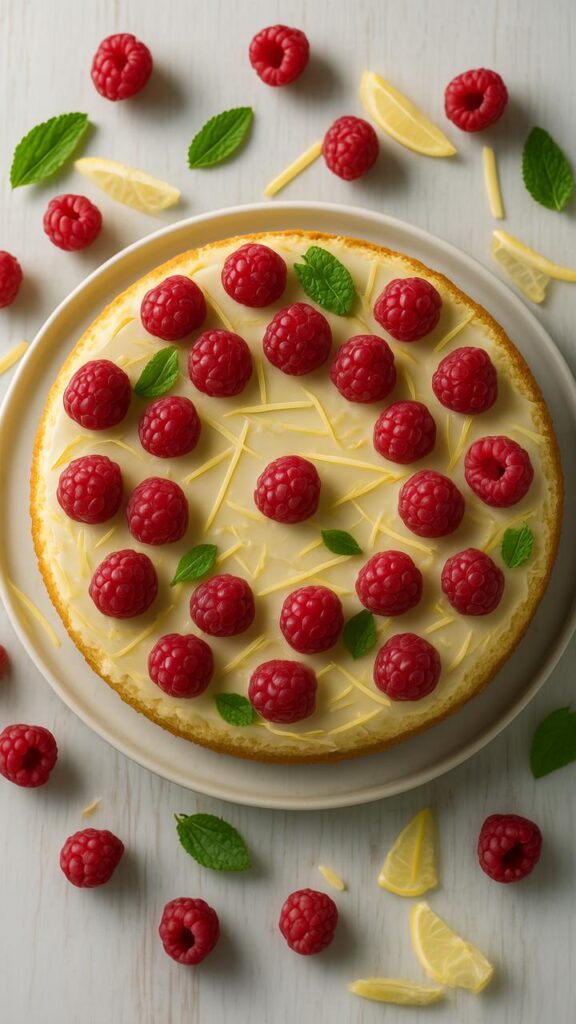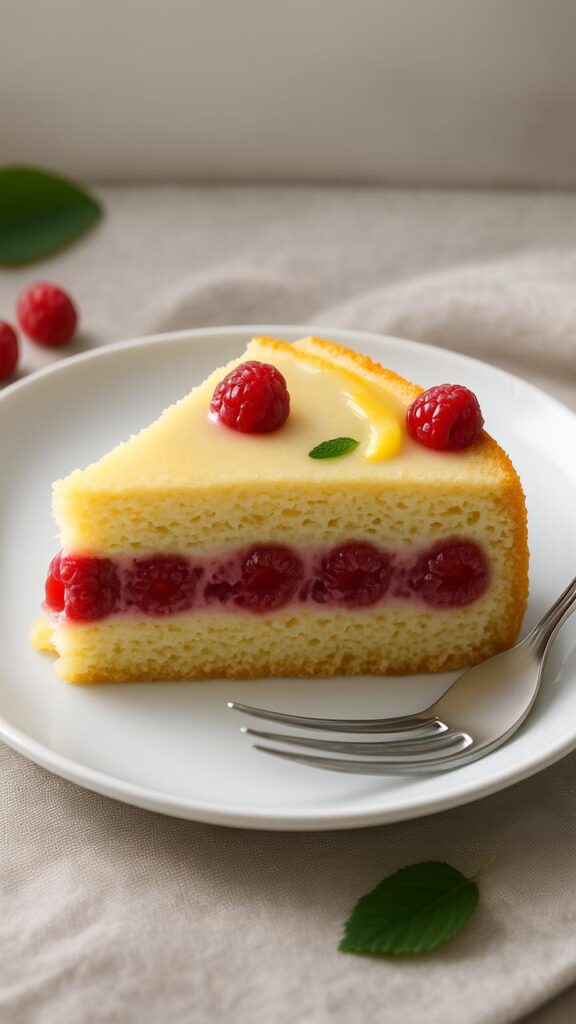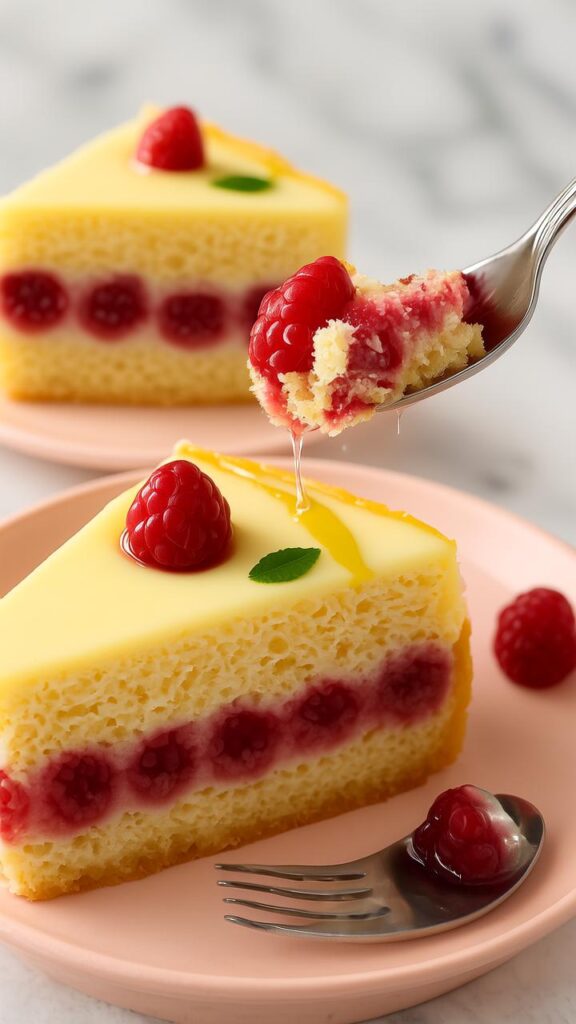Lemon Raspberry Cake is a layered butter cake infused with lemon zest and juice, filled or decorated with raspberries in curd, jam, buttercream or mousse. What makes it special is that perfect balance: tart lemon brightness, juicy raspberries, tender crumb. Unique techniques like zest‑rubbed sugar, flour‑tossed berries, syrup soak, buttercream wall, crumb coating make it both refined and soulful.
Ingredients & Substitutions
Here’s your ingredient list in logical order, with substitutions and selection insight.
- Room‑temperature unsalted butter and granulated sugar. Zest lemon into sugar before creaming to infuse oils.
- Large room‑temp eggs. Warm slightly if needed to bring them up to temp fast.
- Flour mixture: all‑purpose or cake flour for lighter crumb; baking powder; pinch of salt.
- Lemon zest and freshly squeezed lemon juice. Use both for aroma and acidity.
- Buttermilk, sour cream or whole milk. Acidity tenderizes crumb; sour cream adds richness.
- Fresh raspberries ideally; frozen okay if drained and tossed in cornstarch or flour to avoid moisture.
- Optional fillings: lemon curd, raspberry jam or fresh raspberry buttercream. Use thick curd or jam so layers hold.
- Buttercream: lemon‑cream‑cheese or raspberry Swiss style. Cream cheese brings tang; stabilize puree with cornstarch.
Substitutions: For dairy‑free use vegan butter and plant‑based yogurt. For gluten‑free try a reliable cup‑for‑cup flour. For lower sugar use part coconut sugar or erythritol although texture may vary.
Choosing fresh berries gives firmer shape and better flavor. Cake flour yields finer, softer crumb, while all‑purpose is more forgiving and widely available.
Step‑by‑Step Instructions

Here’s how to assemble your cake with small colloquial slips and chef‑level tips.
- Preheat oven to 175 °C (350 °F). Grease and line two 9‑inch pans with parchment.
- Cream butter and zest‑rubbed sugar until pale and fluffy (about 3‑4 mins). Scrape bowl often.
Mistake: undermixing or overcreaming both harm structure. - Add eggs one at a time, beating well after each.
- Whisk together flour, baking powder, and salt.
- Alternate adding dry mixture and lemon‑buttermilk mix: a third dry, half wet, repeat. Stop mixing once just combined—overmixing toughens crumb.
- Toss raspberries (well drained if frozen) in a little flour, fold into batter very gently so they don’t sink.
- Divide batter evenly between pans—use scale or weigh to ensure layer uniformity.
- Bake on middle shelf. Rotate pans halfway through bake for even rise and color. Bake 30–35 minutes or until a skewer comes out clean and cake springs back gently.
- Cool in pans 10 minutes then invert onto racks. Chill before slicing or assembling if needed.
Common Mistakes: Using cold ingredients causing lumpy batter; overmixing after adding flour; skipping berry coating causing sinking; skipping oven rotation leading to domed or uneven cakes.
Variations: Add poppy seeds and almond extract for lemon‑poppy version; stir in white chocolate chips or coconut for texture; swap raspberries for blueberries or mix them.
Cooking Techniques & Science

Why these methods elevate the cake.
- Creaming butter and sugar traps air needed for rise. Eggs emulsify and stabilize that air for structure.
- Zest‑rubbed sugar ensures essential oils from lemon distribute evenly through fat and sugar for maximum aroma.
- Flour‑coated berries give the fruit a dry surface so they suspend in batter, and absorb moisture during bake, preventing sinking or soggy bottom. Also blot dried fruit to remove excess liquid before coating.
- Adding fruit last protects batter color and ensures gentle distribution.
- Syrup soak (brushed on layers) keeps cake extra moist and adds citrus zing if crumb feels too thick.
- Buttercream wall and crumb coat prevent thin fillings like lemon curd or jam from leaking out. Chill between layers for stability.
Key tools: a fine microplane or zester for streak‑free lemon rind; kitchen scale for even layers; offset spatula or palette knife for frosting control; bake‑even strips or pan rotation to avoid domed cakes.
Serving & Pairing Suggestions

Here’s how to showcase and complement your work.
- Slice with knife dipped in hot water and wiped clean for neat presentation. Chill cake before slicing if using soft fillings.
- Garnish top with fresh raspberries, candied lemon wheels or a dust of icing sugar; brush berries with warmed jam for glossy shine.
- Serve with sparkling wine, Prosecco or citrusy cocktail to match brightness.
- Offer alongside light whipped cream or lemon sorbet for a refreshing contrast.
- On a dessert board pair with mild cheese or charcuterie to contrast sweetness.
Conclusion
Lemon Raspberry Cake shines through its balance of tart lemon, juicy berries, tender crumb and thoughtful technique. Creaming sugar and butter properly aerates structure. Flour‑coated berries, syrup brushing, buttercream walls and chilling all push this beyond an average layer cake. With precise mixing, ingredient room‑temp control, and assembly patience, this cake becomes showstopper.
Final Expert Tips: Always bring ingredients to room temp. Cream until pale and airy. Use scale for uniform layers. Chill between frosting steps. Add syrup if cake comes out dry or needs more lemon zing.
Troubleshooting: Dense cake? Probably overmixed or cold components. Raspberries sinking? Must blot and toss in flour or starch. Filling leaking? Build buttercream wall and chill before adding soft layers. Cake dry? Use syrup soak or add more moist components like sour cream.
FAQs
Can I use frozen raspberries?
Yes, thaw and drain them overnight. Blot excess moisture then toss in flour or cornstarch before folding in. This prevents soggy cake and sinking fruit.
How can lemon flavor stay bright?
Rub fresh lemon zest into sugar, use both zest and juice in batter, and consider a drop of lemon extract if more intensity is wanted. Brush syrup if needed.
What if the cake seems dry after baking?
Brush each layer with warm lemon‑sugar syrup before frosting. That revives moisture and lifts lemon aroma.
How to stop filling from leaking?
Apply a thin buttercream dam around edge of layers before adding curd or jam. Chill briefly before adding next layer or final frosting.
Can I prep ahead?
Definitely. Bake layers a day or two ahead and store wrapped in fridge. Assemble and frost on day of serving or chill covered, then bring to room temperature before serving.
This cake is a slice of sunbeams in cake form—bright lemon, palest crumb, luscious raspberries, perfected by technique and care.

Food lover, recipe creator & the heart behind NoshCrafters.com. Olivia shares mouthwatering, easy-to-make dishes that turn everyday meals into unforgettable bites. When she’s not experimenting in the kitchen, she’s busy plating up inspiration for home cooks everywhere.